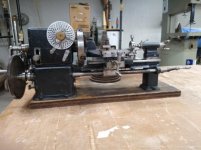NEPA Green
Aluminum
- Joined
- Jan 12, 2013
- Location
- Northeast PA





Overall length 21 3/4". Came with 29 threading gears. This is hand cranked. The three position lever at the left of the head stock disengages spindle from lead screw, engages spindle to turn lead screw same direction as crank, or turns lead screw opposite the direction of the crank.
Has backgears, but so far unable to split spindle shaft.
Three Vs on ways - outer two for the slide and inner one for tail stock and steady rest.
All iron and steel.
Steve






